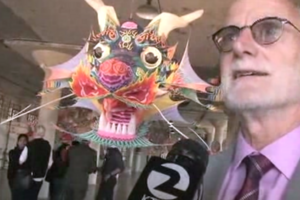'33 Artists in 3 Acts' is a breezy, approachable introduction to the rock stars of the art world
Art critic Sarah Thornton has access to many of the top artists working today, including Jeff Koons, Damien Hirst, Ai Weiwei, Maurizio Cattelan and Cindy Sherman.

Ai Wei Wei exhibit comes to Alcatraz Island.
KTVU
“What is an artist?” asks Sarah Thornton, “in an age when anything can be art?” Thornton, a former art critic for The Economist and the author of the acclaimed "7 Days in the Art World," tries to get answers to this question in 33 Artist in 3 Acts. She fails, in part because of her limited sense of what an artist is (most artists don’t try to pass off urinals as art, à la Duchamp), and perhaps because the question is fundamentally unanswerable. Or rather, one can settle for a simple answer, such as “An artist is someone who makes art,” (as one of her subjects actually says) or attempt to find a more complex answer, which Thornton herself seems to have no appetite to actually pursue.
Thornton has perhaps unparalleled access to many of the top artists working today: Jeff Koons, Damien Hirst, Ai Weiwei, Maurizio Cattelan and Cindy Sherman (to name a few) received her at their homes or studios multiple times. For readers who are curious about contemporary art but know little about it, Thornton has produced a readable, approachable introduction to the rock stars of that world and their work.
This book contains compelling profiles of fascinating people: such as Ai Weiwei, the courageous Chinese dissident artist troubled by the toll his activism has taken on his family; Martha Rosler, whose videos and performance pieces often focus on institutional brutality against women; and the Chilean artist Eugenio Dittborn, whose artistic preoccupation with violence and disappearance are born of his experiences under the Pinochet dictatorship.
But in terms of the intellectual quest Thornton sets herself in the introduction, she can be shockingly superficial and glib at times. She repeatedly has opportunities to engage artists on why they do what they do, elicits statements from them that offer windows into how they see their work and themselves, and repeatedly refuses to pursue the issue.
Ironically she seems to spend a great deal of time with Jeff Koons – an artist notorious for never answering questions directly, when he answers them at all – and getting nowhere in understanding how he sees the role or status of the artist. Yet when other artists make cryptic comments that hint at how they view themselves and what they do – as when Ai Weiwei remarks, “Any awkward moment is a creative moment,” or Laurie Simmons says, “It’s like being a child. My frustration at not being heard and not being seen drives me” – Thornton never follows through with questions, never asks them to tell her (and us) more.
The key to the breezy superficiality of "33 Artists" may lie in Thornton’s admission that “some sentences in these pages first appeared in one of sixty-five articles published [in The Economist].” I began to wonder how many pages of this book consisted of tweaked segments of reviews and profiles. It would explain the journalistic compression of many chapters.
In addition to wondering how much of this book has been recycled from past issues of The Economist, I also found myself reading some chapters of "33 Artists" and wondering: Why is this here? A profile of Lena Dunham simply doesn’t simply doesn’t belong in a book attempting to probe the mysteries of being an artist post-Marcel Duchamp, even if she is the daughter of two actual artists profiled in this book. Even less suitable for this book was the separate chapter on Dunham’s sister Grace, who at the time of writing not only wasn’t an artist (and still isn’t) but was an undergraduate.
I’m not sure what the chapter on the Venice Biennale accomplishes except to showcase Thornton’s capacity for superficiality at the same time that she comes close to striking thematic gold. I wouldn’t have thought it possible for a professional author to write a piece set in Venice completely devoid of sense of place, but she somehow manages it. And her perverse, almost coquettish tendency to set up expectations of depth in specific passages and then leave the reader hanging is maddening. She concludes one paragraph by writing, “As we leave the leafy giardini, I stop to reflect on an artwork by Francis Alÿs, in which he sent a live peacock to the Bienalle preview to represent himself and hang out with his peers. It was titled The Ambassador (2001).” Part of me wanted to shout, “Well what were your reflections?”
And when Laurie Simmons states that “There isn’t anything else [besides being an artist] that would better reflect my sense of who I am,’’ it was frustrating that Thornton didn’t ask, “What *is* your sense of who you are?” But another part of me had gotten used to this sort of narrative tease.
Anyone who wants an introduction to some of the most important contemporary artists would do well to read selected chapters of "33 Artists in 3 Acts." But don’t read it cover to cover.
And certainly don’t read it hoping to find out what an artist is.

